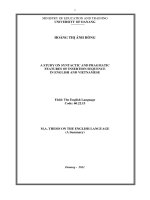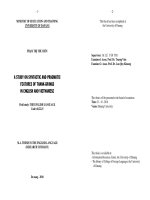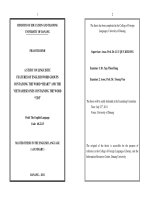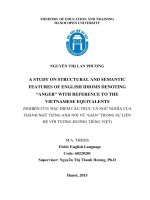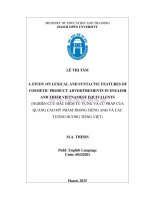A study on syntactic and semantic features of the thinking verb group in english and their vietnamese equivalents
Bạn đang xem bản rút gọn của tài liệu. Xem và tải ngay bản đầy đủ của tài liệu tại đây (1.14 MB, 78 trang )
MINISTRY OF EDUCATION AND TRAINING
HANOI OPEN UNVERSITY
HOÀNG BÍCH NHUNG
A STUDY ON SYNTACTIC AND SEMANTIC
FEATURES OF THE THINKING VERB GROUP IN
ENGLISH AND THEIR VIETNAMESE
EQUIVALENTS
(NGHIÊN CỨU CÁC ĐẶC ĐIỂM CÚ PHÁP VÀ NGỮ NGHĨA
CỦA NHÓMĐỘNG TỪ THINKING TRONG TIẾNG ANH VÀ
TƯƠNG ĐƯƠNG TRONG TIẾNG VIỆT)
M.A. THESIS
Field: English Language
Code: 60220201
Hanoi, 2015
MINISTRY OF EDUCATION AND TRAINING
HANOI OPEN UNVERSITY
HOANG BICH NHUNG
A STUDY ON SYNTACTIC AND SEMANTIC
FEATURES OF THE THINKING VERB GROUP IN
ENGLISH AND THEIR VIETNAMESE
EQUIVALENTS
(NGHIÊN CỨU CÁC ĐẶC ĐIỂM CÚ PHÁP VÀ NGỮ NGHĨA
CỦA NHÓM ĐỘNG TỪ THINKING TRONG TIẾNG ANH VÀ
TƯƠNG ĐƯƠNG TRONG TIẾNG VIỆT)
M.A. THESIS
Field: English Language
Code: 60220201
Supervisor: Dr. Dang Ngoc Huong
Hanoi, 2015
CERTIFICATE OF ORIGINALITY
I, the undersigned, hereby certify my authority of the study
project report entitled “A STUDY ON SYNTACTIC AND SEMANTIC
FEATURES OF THE THINKING VERB GROUP IN ENGLISH AND
THEIR
VIETNAMESEE
QUIVALENTS”
submitted
in
partial
fulfillment of the requirements for the degree of Master in English
Language. Except where the reference is indicated, no other person’s
work has been used without due acknowledgement in the text of the
thesis.
Hanoi, 2015
Hoàng Bích Nhung
Approved by
SUPERVISOR
Đặng Ngọc Hướng
(Signature and full name)
Date:……………………
i
ACKNOWLEDGEMENTS
First and foremost, I would like to express my sincere gratitude to
my supervisor, Dr. Dang Ngoc Huongwho has patiently and constantly
supported me through the stages of the study, and whose stimulating
ideas, expertise, and suggestions have inspired me greatly through my
growth as an academic researcher.
A special word of thanks goes to all the lecturers in the Faculty
ofPost-graduate studies, Hanoi Open Universityand many others,
without whose support and encouragement it would never have been
possible for me to have this thesis accomplished.
Last but not least, I am greatly indebted to my family, my husband
and my loving daughter for the sacrifice they have devoted to the
fulfillment of this academic work.
ii
ABSTRACT
This study is an attempt to uncover the syntactic and semantic
featuresof the English THINKING verbs think, assume, ponder,
remember, know and believe from the analysis of their syntactic and
semantic features based on the theoretical framework of componential
analysis. Special attention was paid to different senses by contexts
where these six verbs are used. In order to help Vietnamese learners of
English to have a deep understanding of other nuances of meanings
conveyed by these English verbs, their Vietnamese translational
equivalents are examined.
The result of the study showed that the six English verbs under
discussion can occur in the same syntactic patterns, but may have
different meanings depending on the situation in which they are used and
they can occur in different syntactic patterns that reflect various meanings
in real- life communication. They also reveal that the meaning of verb is
determined by its relations with other words. That is why we can only
identify exactly the meaning of any word when we have to put it in a
certain context.
A further implication resulting from the findings included in this
study could be equally beneficial for teachers and learners who would
like to expand their knowledge. The most typical ways of perceptivity the
linguistic is analyzed by means of the six English thinking verbs think,
assume, ponder, remember, know and believe.
iii
LIST OF ABBREVIATIONS
A
Adverbial
C
Complement
E
English
NP
Noun phrase
O
Object
S
Subject
Sb
Somebody
Sth
Something
V
Verb
Vi
Vietnamese
iv
LIST OF TABLES AND FIGURES
Table 1
Complement clause possibilities for THINKING verbs
32
Table 2
Frequency of types of structures in English THINKING
39
verbs and Vietnamese THINKING verbs
Table 3
Syntactic features in English thinking verbs and
39
Vietnamese equivalents
Table 4
A summary of the meaning nuances of THINK and their
51
Vietnamese equivalents
Table 5
A summary of the meaning nuances of ASSUME and
51
their Vietnamese equivalents
Table 6
A summary of the meaning nuances of PONDER and
52
their Vietnamese equivalents
Table 7
A summary of the meaning nuances of REMEMBER and
52
their Vietnamese equivalents
Table 8
A summary of the meaning nuances of KNOW and their
53
Vietnamese equivalents
Table 9
A summary of the meaning nuances of BELIEVE and
53
their Vietnamese equivalents
Table 10 A Summary of the comparison of the meaning nuances
54
of THINK, ASSUME, PONDER
Table 11 A summary of the comparison of the meaning nuances
54
of REMEMBER, KNOW andBELIEVE
Table 12 A summary of THINKING verbs and their Vietnamese
55
equivalents
v
TABLE OF CONTENTS
Certificate of originality
i
Acknowledgements
ii
Abstract
iii
List of abbreviations
iv
List of tables and figures
v
CHAPTER1 INTRODUCTION
1
1.1
Rationale
1
1.2
Aims of the research
2
1.3
Objectives of the research
3
1.4
Scope of the research
3
1.5
Significance of the research
3
1.6
Structural organization of the thesis
4
CHAPTER 2LITERATURE REVIEW
6
2.1
Previous studies
6
2.2
Review of theoretical background
7
2.2.1
Theoretical framework
7
2.2.1.1
Theory of syntax
7
2.2.1.2
Theory of semantics
8
2.2.1.3
Overview of English verbs
10
2.2.1.3.1 Definition of the verb
10
2.2.1.3.2 Verb classification
12
2.2.2
Theoretical background
14
2.2.2.1
Overview of the THINKING verbs
14
2.2.2.2
Concepts of the THINKING verbs
15
2.3
Summary
17
vi
CHAPTER 3 METHODOLOGY
18
3.1
18
Research-governing orientations
3.1.1 Research questions
18
3.1.2 Research setting
18
3.1.3 Research approach
19
3.1.4 Principles/criteria for intended data collection and data analysis
19
3.2
20
Research methods
3.2.1 Major methods and supporting methods
20
3.2.2 Data collection techniques
21
3.2.3 Data analysis techniques
22
3.3
22
Summary
CHAPTER 4 FINDINGS AND DISCUSSION
24
4.1
24
Syntactic features of the THINKING verbs in English and their
Vietnamese equivalents
4.1.1
Syntactic features of THINKING verbs
24
4.1.1.1
Object as NP and object omission
25
4.1.1.2
Complements
28
4.1.2
The THINKING verbs and their Vietnamese equivalents with
33
respect to syntactic features
4.1.2.1
THINK and their Vietnamese equivalents
33
4.1.2.2
ASSUME and their Vietnamese equivalents
34
4.1.2.3
PONDER and their Vietnamese equivalents
35
4.1.2.4
REMEMBER and their Vietnamese equivalents
36
4.1.2.5
KNOW and their Vietnamese equivalents
37
4.1.2.6
BELIEVE and their Vietnamese equivalents
38
4.2
The THINKING verbs and their Vietnamese equivalents with
40
respect to semantic features
vii
4.2.1
Semanticfeatures of the THINKING verbs in English
40
4.2.2
The equivalents of semanticfeatures of the THINKING verbs in
51
Vietnamese
4.3
Implications for teaching and learningthe THINKING verbs
55
4.4
Summary
60
CHAPTER 5 CONCLUSION
62
5.1
Recapitulation
62
5.2
Concluding remarks
64
5.3
Limitation of the research
65
5.4
Suggestions for a further research
65
REFERENCES
viii
CHAPTER 1
INTRODUCTION
1.1 Rationale
The verb is perhaps the most important part of the sentence. A verb
states what is happening in the sentence.There are many verbs in Englishand
the THINKING verbs play an important role in the sentence. However, in
communication, we have difficulties in expressing our ideas, especially in
transferring meanings of words from a language to another one, in our case
from English to Vietnamese.
It is known that the ability to express freely in communication is of
great importance forfuture career, especially in modern societies where
contacting with foreigners often occurs. In addition, there still exist many
difficulties in learning and teaching English in Vietnam. Many Vietnamese
learners can write and read English quite well but they do not use it correctly
and fluently in real-life communication.
There have been a lot of researchers conducting investigations into
THINKING verbs in both English and Vietnamese. In English with these
studies:Anna Wierzbicka (1972) she studies about the semantic features of
verbs such as: think, know, and want;R. M. W. Dixon (1991),A new approach
to English grammar on semantic principles; Gilbert Ryle (2009), Concept of
mind; Richard Faure (2009), Verbs of thinking and speaking;Susanna Karlsson
(2008), Re-thinking THINK in contrastive perspective. In Vietnam with studies:
Hoàng Tuệ (1962), Giáo trình việt ngữ ; Nguyễn Kim Thản (1997),Động từ
trong tiếng Việt; Hoàng Phê (1998), Vietnamese dictionary. In some Journals
of Science and technology Lê Minh Giang and Ngũ Thiện Hùng (2011), Sự
khác nhau giữa động từ thực hữu và không thực hữu trên cứ liệu tiếng Anh và
1
đối dịch tiếng Việt; Nguyễn Thị Thu Hà (2012), Ngữ nghĩa của động từ nghĩ
trong tiếng Việt. These studies thoroughly describe about the semantic
features of the THINKING verbs but they have not been exploited in terms of
their syntactic features yet. Moreover, the equivalents between two languages
English and Vietnamese has not been implemented yet.
In the process of teaching English verbs in general, and teaching the
THINKING verbs in particular, it is recognized that this verb group makes
students confused much especially their syntactic and semantic features of the
THINKING verb group and their Vietnamese equivalents.
As there are a lot of THINKING verbs, learners can use different
words to express their ideas. However, a great number of peoplemake
mistakeswhen they usethe THINKINGverbsin different situations to
communicate.
To compare the syntactic and semantic features of the
THINKING verbsare important to learners, so that they can have good
knowledge to use these THINKING verbs correctly.
For the above reasons, the topic “A Study on syntactic and semantic
features of the THINKING verb groupin English and their Vietnamese
equivalents” is chosen with the purpose of finding out the equivalents of
English and Vietnamese THINKING verbs.Especially, the study only focuses
on six English THINKING verbs think, assume, ponder, remember, know and
believe.We hope that with the thesis, we can contribute a small part to help
students of English as well as Vietnamese people who learn English and who
are interested in English THINKING verbs.
1.2Aims of the research
The thesis is aimed at investigating the syntactic and semantic
features of English THINKING verbs in English and their Vietnamese
2
equivalents with a view helping Vietnamese learnershave a better
understanding of the THINKING verbs andsuggesting some implications
for teachingand learning these English verbs.
1.3 Objectives of the research
To achieve the mentioned aims above, following objectives can be put
forward:
1. Pointing out the syntactic and semantic features of the THINKINGverbs
in English and their Vietnamese equivalents.
2. Finding outthe similarities and differences of the THINKING verbs in
English and their Vietnamese equivalentsin terms of syntactic and semantic
features.
3. Providing some implications forteachingand learning the THINKING
verbs.
1.4. Scope of the research
Within the framework of a master thesis, only the syntactic and
semantic features of the English THINKING verbs will be taken into
consideration. Other features will be out of the scope of this study.
To serve the purpose of the study, some implications will be
suggested to help Vietnamese learners of English have a better
understanding of the THINKING verbs and then use them in daily
communication effectively.
1.5. Significance of the research
i) Theoretical significance
3
Theoretically, the study will provide a full description of syntactic
and semantic features of the English verbs, so other researchers and
linguistics could take it as a reliable reference to make further studies in this
field.Moreover, the similarities and differences between these verbs in
English and in Vietnamese are very helpful in contrasting two languages.
ii) Practical significance
Practically, the study will help the Vietnamese learners of English as
a foreign language use the English THINKING verbs effectively in daily
communication. The findings of the study is hopefully to be beneficial to
those whose are engaged in teaching English as well as those who want to
learn English as a foreign language.
1.6 Structure of theresearch
Thestudy
isorganizedintofivechapters:
Introduction,
Literature
Review, Methodology, Findings and Discussion, and Conclusion.
Chapter1 - Introduction - gives the reason why this topic has been
chosen for the research as well as its aims and objectives, scope,
significance and organizational structure.
Chapter2 – Presents theLiteratureReview including all the previous
studies related to the research area and a review of theoretical
background,which is considered as a foundation for conducting the whole
research.
Chapter 3 – Methodology – describes all the research-governing
orientation and methods applied for implementing this research.
Chapter 4 – Findings and Discussion – gives a detail description and
discussion on the syntactic and semantic feature of THINKING
4
verbstogether with some possible implications for teaching and learning the
English THINHKING verbs.
Chapter 5 – Conclusion – summaries the whole content of the
research, indicate the limitation, thus giving some recommendation and
suggestion for a further research.
References come at the end of the study.
5
CHAPTER 2
LITERATURE REVIEW
The following issues are to be dealt with in this chapter: Previous
studies; Review overview oftheoretical background. These theories are the
basis of the study in the chapter four.
2.1 Previous studies
There have been many researchers conducting investigations into
THINKING verbs in both English and Vietnamese.
For THINKING verbs in English, Anna Wierzbicka (1972) she studies
about the semantic features of verbs such as: think, know, and want. etc,.
Besides, according to R. M. W. Dixon (1991),A new approach to English
grammar on semantic principles. In his study, he pointed that the THINKING
verbs include eight English verbs: think, assume, ponder, remember, know,
conclude, solve and believe. Two these authors studies about the semantic of
these verbs in terms of semantic features.
Gilbert Ryle (2009), Concept of mind discusses the definition of the mind.
Richard Faure (2009), Verbs of thinking and speaking. The author has already
discussed the similarities and the differences between verbs of thinking and
speaking. Although the research has mentioned the syntactic as well as the
semantic features, it has only mentioned the equivalents of these verbs in
English and French.
Susanna
Karlsson
(2008),
Re-thinking
THINK
in
contrastive
perspective.In his study, he discussed eight verbs: think, know, feel, see, hear,
see, wantanddoin terms of syntactic and semantic features in English and
Swedish equivalents.
About Vietnamese THINKING verb group, Hoàng Tuệ (1962), Giáo
trình việt ngữ and Nguyễn Kim Thản (1997),Động từ trong tiếng Việt, these
authors studied about the classification of words in Vietnamese including the
6
THINKING verbs in Vietnamese. Hoàng Phê (1998), Vietnamese dictionary
analyzed and improved to the meaning and the structures of the THINKING
verbs. In addition, some authors of Journal of Science and technology in Da
nang and Journal of Science of Hue University such as: Lê Minh Giang and
Ngũ Thiện Hùng (2011), Sự khác nhau giữa động từ thực hữu và không thực
hữu trên cứ liệu tiếng Anh và đối dịch tiếng Việt. These researchers studied
about the distinction between factive verbs and non- factive verbs in English and
Vietnamese translational equivalents. Nguyễn Thị Thu Hà (2012), Ngữ nghĩa
của động từ nghĩ trong tiếng Việt. She has only mentioned the meaning of think
verb in Vietnamese. The author did not discuss or contrast the equivalents of the
think verb in English.
Although all the studies above thoroughly describe about the semantic
or the meaning features of the THINKING verbs, they have not been
exploited in terms of their syntactic features yet. Especially, the equivalents
between two languages English and Vietnamese has not been implemented
yet. Moreover, the implications for teachingandlearning the THINKING
verbs from English into Vietnamese have not carried out yet.
As a result, that is why this research studies about the THINKING verb
group. The THINKING verb group of this study consists of six verbs as
follows: think, assume, ponder, remember, know and believe. In this paper,
the features of syntactic as well as semantic of the THINKING verbs will be
analyzed clearly from many different resources.
2.2 Review of theoretical background
2.2.1 Theoretical framework
2.2.1.1 Theory of syntax
Syntax is a set of rules in language. It dictates how words from different
parts of speech are put together in order to convey a complete
thought.
According to R.M.W. Dixon (1991), syntax deals with the way in which words
7
are combined together. Verbs have different grammatical properties from
language to language but there is always a major class verb, which includes
word referring to motion, rest, attention, giving and speaking.
Syntax is understood to be the theory of the structure of sentences in a
language. This view has its direct antecedents in the theory of immediate
constituents, in which the function of syntax is to mediate between the observed
forms of a sentence and its meaning.
Bloomfield (1993), he states “we could not understand the form of a
language if we merely reduced all the complex forms to their ultimate
constituents”. He argued that in order to account for the meaning of a sentence,
it is necessary to recognize how individual constituents such words and
morphemes constitute more complex forms.
Syntax is now the study of the principles and rules that govern the ways
in which words are combined to form phrases, clauses and sentences in a
language. Syntax, which is a subfield of grammar, focuses on the word order of
a language and the relationships between words. In other words, morphology
deals with word formation out of morphemes whereas syntax deals with phrase
and sentence formation out of words.
Syntax structures are analyzable into sequences of syntactic categories or
syntactic classes, these being established on the basic of the syntactic
relationships and linguistic items have with other items in a construction.
Every language has a limited number of syntactic relations. Subject and
object are probably universal of syntactic relations, which apply to every
language. However, just as the criteria for the major words class noun and verb
differ from language to language, so do the ways in which syntactic relations are
marked.
2.2.1.2 Theory of semantics
Semantics is a branch of linguistics, which deals with meaning or the content of
communication. According to Hurford and Heasley (1983:1), “semantics is the
8
study of meaning in language”. Language is a means of communication, and
people use language to communicate with others by making conversations,
giving information, and other things to make social relationship. Human beings
have been given the capacity to talk, to communicate with each other, to make
meaningful utterances, so that they are understood by other human beings. They
communicate about the world in which they live, about themselves, about their
thought and feeling, about what has happened, about what might happen or what
they would like to happen, and a lot more.
Hurford and Heasley (1983:5) state, “the giving of information is itself an act of
courtesy, performed to strengthen social relationships”. This is also part of
communication. There are some linguists that try to define semantics. Moreover,
as quoted by Lyons (1977) at first defines semantics as the study of the relations
of signs to the objects to which the signs are applicable. And then he revises his
definition, saying that, semantics is that portion of semiotic which deals with the
signification of sign in all modes of signifying.
Semantics is usually connected with pragmatics Carnap (Lyons, 1977:116) says
that descriptive semantics (i.e. the investigation of the meaning of expressions in
“historically given natural language”), may be regarded as part of pragmatics.
The reason why descriptive semantics is part of pragmatics seem to have been
that he believed that difference in the use of particular expressions were not only
inevitable in language - behaviour, but must be taken account of in the
description or context. Smith, as quoted by Lyons (1977:116) states that
“semantics studies how these signs are related to things. And pragmatics studied
how they are related to people”. According to Leech (1983:5) in practice, the
problem of distinguishing language and language use has centred on a boundary
dispute between semantics and pragmatics. Hurford and Heasley (1983:14)
further explain that the study of semantics is largely a matter of conceptually and
exploring the nature of meaning in a careful and thoughtful way, using a wide
range of examples, many of which we can draw from our knowledge. But Jack
9
Richards, John Platt, Heidi Weber (1987:172) state that “the study of meaning is
semantics. Semantics is usually concerned with the analysis of the meaning of
words, phrases, or sentences and sometimes with the meaning of utterances in
discourse or the meaning of a whole text.”
David Crystal (1992:347) defines that “semantics is the study of meaning in
language”. Structural semantics applied the principles of structural linguistics to
the study of meaning through the notion of semantic relations (also called sense
relation), such as synonymy and antonyms. In generative grammar, the semantic
component is a major area of the grammar’s organization, assigning a semantic
representation to sentences, and analyzing lexical terms of semantic features.
The theory of semantic field views vocabulary as organized into areas, within
which words (lexical items) interrelate and define each other.
Theory of syntactic and semantic is carried out first with main purpose to decide
the theoretical framework of the study in the chapter four.
2.2.1.3 Overview of English verbs
2.2.1.3.1Definition of the verb
In most languages, verbs are part of speech expressing existence, action,
or occurrence. Moreover, verb is considered to be the king of all parts of speech
in English. At the heart of every sentence is a verb, an action word that is
generally indicates what someone or something is doing or perhaps merely
indicates being.
R.M.W.Dixon (1991) defines that “a verb is the center of a clause”. A
verb refer to some activity and there must be a number of participants who have
roles in that activity as: Sinbad carried the old man; or it may refer to a state,
and there must be a participant to experience the state as: My leg aches.
A set of verbs is grouped together as one semantic type partly because
they require the same set of participant roles. All giving verbs require a Donor, a
Gift and a Recipient, as in:
John gave a bouquet to Mary, Jane lent the Saab to Bill.
10
Or:
The women’s Institutes supplied the souldiers with socks.
(R.M.W.Dixon, 1991: 9)
All attention verbs take a Perceiver and an Impression (that which is seen
or heard), as in:
I heard the crash, I witnessed the accident, I recognised the driver’s face.
(R.M.W.Dixon, 1991: 9)
Affect verbs are likely to involve an Agent, a Target, and something
which is manipulated by the Agent to come into contact with the target which I
call manip. A manip can always be stated, although it often does not have to be.
Let’s see the following examples:
John rubbed the glass (with a soft cloth).
Mary sliced the tomato (with her new knife).
Tom punched Bill (with his left fist).
(R.M.W.Dixon, 1991: 9)
L.G Alexander (1983) points out a verb is a word or a phrase which
expresses the existence of a state or doing an action.
Oxford Advanced Learner’s Encyclopedic (1998) states that a verb is a word or
a phrase indicating an action, an event or state.
According to Borahash (1975), the verb is a part of speech denoting an action or
a process.
According to Jack C. Richards & et al (1992), a word is a verb when it
satisfies these following criteria:
- Occurs as part of the predicate of a sentence
- Caries markers of grammatical categories such as tense, aspect,
person, number, and mood
- Refers to an action or state
11
Generally in English, the verb tense shows the time of the action or state;
the aspect of a verb defines the temporal flow (or lack thereof) in the described
event or state.
Thompson (1965), states that verbs are not affected by number, person,
gender, mood, voice, and tense.
2.2.1.3.2 Verb classification
According to R. Quirk et al (1985), verbs are classified into two types:
intensive verbs and extensive verbs.
a. Intensive verbs
Intensive verbs are also called copular verbs, and they are usually
followedby a noun, or a noun phrase, and adjective or prepositional phrase.
Intensive verbs are used to describe the subject. It means that the focus is on one
thing – the subject only. Intensive verbs appear in the structure “S V C” or “S V
A”. Words or phrases, which are followed by an intensive verb work as the
subject compliment and they apply to the subject, not the verb. Let’s consider
the following examples:
Your dinner seems ready (SVC)
My office is in the next building. (SVA)
(Quirk, Randolph, 1985: 721)
b. Extensive verbs
Extensive verbs are most other verbs, they do not have subject
compliment. Extensive verbs are used to say what the subject is doing. It coversa
wider area; it takes the information away from the subject. Words or phrases,
which are followed by an extensive verb work as the verb’s object. They apply
to the verb, not the subject as in:
He stayed very quiet.
12
(Quirk, Randolph, 1985: 55)
Extensive verbs include three small types: monotransitive, complex
transitive and ditransitive.
Di transitive verbs are verbs which take a subject and two objects or have
the structure “S V O O”. According to certain linguistic considerations, these
objectives may be called direct, indirect objectives, or primary and secondary
objectives as in the following examples:
I must send my parents an anniversary card. (SVOO)
(Quirk, Randolph, 1985: 721)
In contrast, mono transitive verbs take only one object and appear in the
structure “S V O” as in the following examples:
That lecture bored me. (SVO)
(Quirk, Randolph, 1985: 721)
Verb requires both a direct object and another object or an object
complement is complex transitive verbs. Complex transitive verbs appear in the
structure “S V O C” or “S V O A”. In a complex- transitive construction, the
object complement identifies a quality or attributes pertaining to the direct
object. Let’s consider the following examples:
Most students have found her reasonably helpful. (SVOC)
You can put the dish on the table. (SVOA)
(Quirk, Randolph, 1985: 721)
The verb is perhaps the most important part of the sentence. A verb
states what is happening in the sentence. Finite verbs locate the condition or
action of the verb in a specific time frame: past, present or future and have a
13
specific tense and a subject with which they grammatically agree. A
complete sentence must contain a finite verb. Verbs create the relationship
between the subject and the object of the verb.
In a command, there is still this relationship with the subject and
object understood. “Go!” (Subject –you– understood, verb “go!”
object away– understood.)
The form of the verb must agree with the number of its subject, which
will be a noun or noun group, for example 'They were not home' (as
opposed to 'They was not home'). Confusion can arise when deciding
whether the subject is singular or plural, for example 'This group of students
is very clever', or when there are two subjects, for example 'Ice cream and
strawberries are delicious' (not 'is delicious').
2.2.2 Theoretical background
2.2.2.1Overview of the THINKING verbs
In general, in English, there are thinking verbs whose frequency of use is
very high in both English and Vietnamese. Besides, thinking verbsare found in
English as: Anna Wierzbicka (1972) studies about the semantic features of
verbs such as: think, know, and want. On the other hand, in another study of
R. M. W. Dixon (1991),A new approach to English grammar on semantic
principles. These studies studied on the semantic of these verbs in terms of
semantic features.
Gilbert Ryle (2009), Concept of mind. Richard Faure (2009), Verbs of
thinking and speaking. The authors have already discussed the discusses the
definition of the mind and similarities and the differences between verbs of
thinking and speaking. Susanna Karlsson (2008), Re-thinking THINK in
contrastive perspective. The research studied on syntactic and semantic features
14
of eight verbs: think, know, feel, see, hear, see, want anddo in English and their
Swedish equivalents.
In Vietnam, the THINKING verbs found by these authors such as:
Hoàng Tuệ (1962), Giáo trình việt ngữ and Nguyễn Kim Thản (1997),Động
từ trong tiếng Việt, these authors studied about the classification of words in
Vietnamese including the THINKING verbs in Vietnamese. Hoàng Phê
(1998), Vietnamese dictionary analyzed and improved to the meaning and the
structures of the THINKING verbs. In addition, some authors of Journal of
Science and technology in Da nang and Journal of Science of Hue University
such as: Lê Minh Giang and Ngũ Thiện Hùng (2011), Sự khác nhau giữa động
từ thực hữu và không thực hữu trên cứ liệu tiếng Anh và đối dịch tiếng Việt.
These authors studies about the distinction between factive verbs and nonfactive verbs in English and Vietnamese translational equivalents. For the author
Nguyễn Thị Thu Hà (2012), Ngữ nghĩa của động từ nghĩ trong tiếng Việt. The
author has only mentioned the meaning of think verb in Vietnamese. The author
did not discuss or contrast the equivalents of the think verb in English.
Although all the studies above thoroughly describe about the semantic
or the meaning features of the THINKING verbs, they have not been
exploited in terms of their syntactic features yet. Especially, the equivalents
between two languages English and Vietnamese has not been implemented
yet. Moreover, the implications for teachingand learning the THINKING
verbs from English into Vietnamese have not carried out yet.
The researches above are the background that the theory part of the study
will be carried out.
2.2.2.2Concepts of the THINKING verbs
According to Susanna Karlsson (2008), the THINKING verbsare known
as follows: We use thinking verbs to refer to cognitive processes such as
thinking, wondering, knowing and remembering:
15
